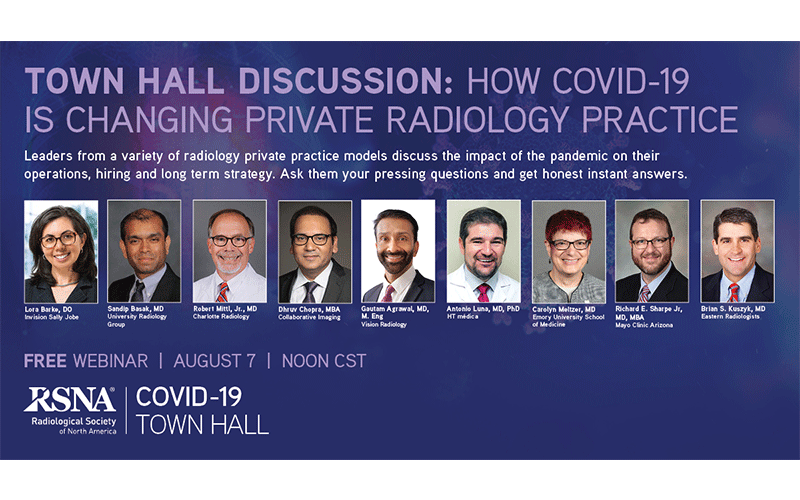Experts: Radiology Private Practices Will Need to be Flexible, Resilient in a Post-Pandemic World
Leaders at RSNA Town Hall share COVID-19 experiences, strategies for the future

While the ongoing COVID-19 pandemic has affected nearly every corner of health care, radiologists in private practice have been hit especially hard.
In fact, radiology leaders who gathered for an Aug. 7 virtual RSNA Town Hall, “How COVID-19 is Changing Private Radiology Practice,” say the pandemic has not only changed the way private practices operate today, but also how they will be managed in the future.
“The pandemic has exposed the need for practices to be more efficient, to be more data driven, and to focus on diversifying their revenue streams,” said Dhruv Chopra, MBA, CEO, Collaborative Imaging, which comprises 550 radiologists in eight states, during the town hall.
Leaders from a variety of radiology private practice models shared their experiences with operations, safety, hiring, and long-term strategy. The discussion was moderated by Carolyn Meltzer, MD, RSNA Board liaison for science, Richard E. Sharpe Jr., MD, MBA, radiologist, senior associate consultant, Mayo Clinic in Arizona, and Brian S. Kuszyk, MD, president, Eastern Radiologists, NC.
When the pandemic began sweeping the country in March, elective imaging procedures were restricted or postponed, drastically reducing imaging volume at many private practices. According to a poll taken during the RSNA Town Hall, about half of respondents said their imaging volume dropped by 60% to 80% at the height of the pandemic.
Sandip Basak, MD, president of University Radiology Group, with 22 offices in New Jersey, said referral volumes dropped to 15% of the company’s normal imaging volumes during the second week of April.
“The impact on revenue was profound,” Dr. Basak said. “But we also have to talk about the significant psychological impact on our radiologists and staff. The extent of anxiety and fear in the early days of the crisis cannot be overstated.”
According to Lora Barke, DO, medical director at Invision Sally Jobe, a network of 13 imaging centers in the Denver area, there was a dramatic drop in the volume of mammograms at the height of the pandemic, forcing the company to consolidate services and furlough staff to get through that period.
Shifting to Remote Work
Before the pandemic, there was a preference among many imaging facilities to have radiologists on site versus working from remote locations. But town hall panelists said practices with the ability to quickly shift to teleradiology were most likely to survive COVID-19.
According to Robert Mittl, Jr., MD, president, Charlotte Radiology, based in North Carolina, his practice immediately began using video calls to conduct remote interactive consults, share screens with referring physicians, provide virtual care to patients, hold interdisciplinary conferences, do administrative work and teach medical students.
A similar experience was shared by Chopra, who said his practice relied heavily on teleradiology throughout the pandemic.
“We had to utilize technology to a far greater extent than ever before, but the number one priority was to make sure we could continue to deliver patient care,” Dr. Chopra said. “Radiologists working remotely ensured the safety of patients and staff.”
Gautam Agrawal, MD, CIO and co-founder of Vision Radiology in Texas, said all of his personnel already work from home so there was less transition time, while others had to create a new workflow and communications process to accommodate the change.
“We saw a fast, general acceptance of teleradiology and it shifted the discussion going forward,” Dr. Agrawal said. “We’ve seen a massive influx in people who are interested in teleradiology as a career.”
As circumstances continue to change, experts at the town hall said communication has been key. “We probably communicate more than we did pre-COVID,” Dr. Barke said.
Panelists said daily or weekly communication, internal and external, was necessary to help staff keep up with changing regulations, case volumes, safety procedures, the financial impact and more.
Facing New Challenges
Well into August, another poll taken during the RSNA Town Hall showed that about 65% of respondents said they are still seeing total practice volumes that are lower than before the pandemic and said it may be a slow road back.
“We learned that ramping down was much easier than ramping up,” Dr. Basak said. “That surprised me.”
During the height of the pandemic, 14 offices at University Radiology Group were closed while eight others reduced hours, Dr. Basak said. By June, nearly all the offices were reopened, but faced a host of challenges, including implementing new procedures, retraining furloughed staff, and changing scheduling to accommodate patient/staff distancing and cleaning of the facilities.
Dr. Mittl said the financial impact may lead to smaller practices exploring options such as joining a hospital system, joining a consortium or consolidating. The future will also bring a critical need for resilience within practices, Dr. Barke said.
While experts think the need for increased personal protective equipment (PPE) and cleaning supplies is here to stay, the changing nature of the pandemic has taught many to expect the unexpected and the importance of flexibility.
“We don’t really know what the future is going to hold, and everyone wants to be prepared just in case,” Dr. Barke said.
For More Information
Access RSNA COVID-19 Resources for all the on-demand COVID-19 related webinars and education.